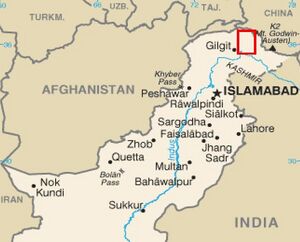Dvarapala
| Author:Laxman Burdak, IFS (R) |

Dvarapala (द्वारपाल) was a country and tribe mentioned in Mahabharata who were subjugated by Nakula. It is the ancient name of Khyber Pass, which is a mountain pass connecting Afghanistan and Pakistan.
Origin
Variants
Jat clans
History
Sandhya Jain[1] mentions Dvarapala (द्वारपाल) as a northwestern region, mentioned In Nakula's conquests in Mahabharata (II.29.10) in the list of Tribes With unclear Position in Kurukshetra War.
In Mahabharata epic we find mention of Dwarapala tribe which is synonymous with Pratihara, who are dwelling in the neighbourhood of Ramathas. Thus the search of Ramatha from various Parvas we can find Pratihara Kshatriyas located on the western borders of India in Mahabharata period.
The Uttarajyotika seems to have been the same as Landikotala, Vrindataka as Burindu and Attuck and Dvarpala as the Khybar.[2]
Dwarapala in Mahabharata
Dvarapala (द्वारपाल) in Mahabharata (II.29.10) , (III.81.42)
Sabha Parva, Mahabharata/Book II Chapter 29 mentions deeds and triumphs of Nakula where he defeats Dwarapala tribe which is synonymous with Pratihara...". ....and the whole of the country called after the five rivers Panchanada, and the mountains called Amara Parvata , and the country called Uttarajyotika and the city of Divyakutta and the tribe called Dwarapala. And the son of Pandu (Nakula), by sheer force, reduced to subjection the Ramathas, the Harahunas, and various kings of the west..." (Mahabharata, II.29.10). [3]
Vana Parva, Mahabharata/Book III Chapter 81 mentions names of Tirthas (Pilgrims). Dvarapala (द्वारपाल) is mentioned in Mahabharata (III.81.42).[4].....O king, one should then proceed to the tirtha called Arantuka (अरन्तुक) (3.81.42)situated in the Saraswati and belonging to the illustrious chief of the Yakshas who is one of the gate-keepers (Dvarapala)= (द्वारपाल) (of Kuvera). O king, bathing there one obtaineth the fruit of the Agnishtoma sacrifice.
द्वारपाल
विजयेन्द्र कुमार माथुर[5] ने लेख किया है ...द्वारपाल (AS, p.459) महाभारत, सभापर्व के उल्लेख के आधार पर ख़ैबर दर्रे का प्राचीन भारतीय नाम समझा जाता है। अपनी भौगोलिक संरचना के कारण द्वारपाल वास्तव में भारत का 'द्वार रक्षक' था। 'द्वारपाल च तरसा वशे चक्रे महाद्युति:, रामठान् हारहूणांश्च प्रतीच्यश्चैव ये नृपा:'महाभारत, सभापर्व 32, 12.
पाण्डव नकुल ने अपनी दिग्विजय यात्रा के प्रसंग में उत्तर-पश्चिम दिशा के अनेक स्थानों को जीतते हुए द्वारपाल पर भी प्रभुत्व स्थापित किया था। प्रसंग से द्वारपाल, अफ़ग़ानिस्तान और भारत के बीच द्वार के रूप में स्थित खैबर दर्रें का प्राचीन भारतीय नाम जान पड़ता है। यह वास्तव में भारत का द्वार रक्षक था। इस उल्लेख से यह बात स्पष्ट है कि प्राचीन काल में भारतीयों को अपनी उत्तर-पश्चिम सीमा के इस दर्रे का महत्त्व पूरी तरह से ज्ञात था। उपर्युक्त श्लोक में 'रमठ' और 'हारहूण' अफ़ग़ानिस्तान के ही प्रदेश हैं, जिससे द्वारपाल से खैबर दर्रे का अभिज्ञान निश्चित ही जान पड़ता है। इन सब स्थानों को नकुल ने 'शासन' भेजकर ही वश में कर लिया था और वहाँ सेना भेजने की आवश्यकता नहीं पड़ती थी- 'तान् सर्वान् स वशे चक्रे शासनादव पांडव:'। महाभारत, वनपर्व 83,15 में भी द्वारपाल का उल्लेख है- 'ततो गच्छेत धर्मज्ञ द्वारपालं तरन्तुकम्'।
External links
References
- ↑ Sandhya Jain: Adi Deo Arya Devata - A Panoramic View of Tribal-Hindu Cultural Interface, Rupa & Co, 7/16, Ansari Road Daryaganj, New Delhi, 2004, p. 135, sn. 114.
- ↑ Proceedings and Transactions of the ... All-India Oriental Conference, Part 1, 1966 - All-India Oriental Conference,p.148
- ↑ कृत्स्नं पञ्चनदं चैव तदैवापरपर्यटम, उत्तरज्यॊतिकं चैव तदा वृण्डाटकं पुरम, द्वारपालं च तरसा वशे चक्रे महाथ्युतिः (Mahabharata, II.29.10); रमठान हारहूणांश च परतीच्याश चैव ये नृपाः, तान सर्वान स वशे चक्रे शासनाथ एव पाण्डवः (Mahabharata, II.29.11)
- ↑ ततॊ गच्छेत राजेन्द्र दवारपालम अरन्तुकम, तस्य तीर्थं सरस्वत्यां यक्षेन्द्रस्य महात्मनाः, तत्र सनात्वा नरॊ राजन्न अग्निष्टॊम फलं लभेत (III.81.42)
- ↑ Aitihasik Sthanavali by Vijayendra Kumar Mathur, p.459

